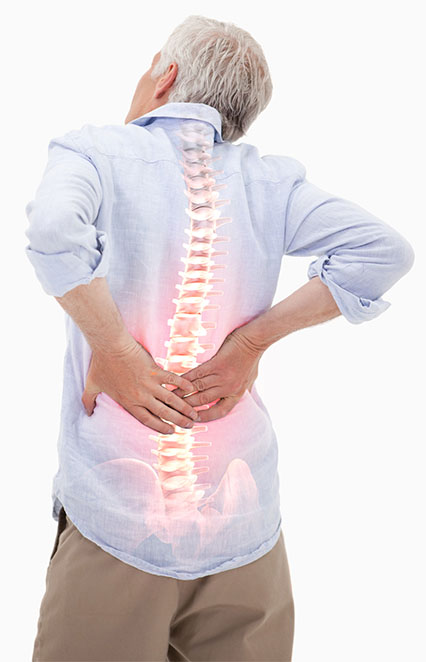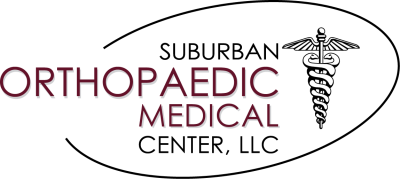FAQs
- Home
- /
- FAQs
Frequently Asked Questions
Below you will find frequently asked questions about Suburban Orthopedic Medical Center's specialties including: Chiropractic, Interventional Pain Management, Physical Medicine and Rehabilitation, Physical Therapy and Orthopedics.
Frequently Asked Questions About Chiropractic Care
What conditions do chiropractors treat?
Doctors of Chiropractic are especially well known for their expertise in caring for patients with back pain, neck pain, and headaches; particularly with their highly skilled manipulations or chiropractic adjustments. They also care for patients with a wide range of injuries and disorders of the musculoskeletal system, involving the muscles, ligaments, and joints. These painful conditions often involve or impact the nervous system, which can cause referred pain and dysfunction distant to the region of injury. The benefits of chiropractic care extend to general health issues as well, since our body structure affects our overall function. Chiropractors also counsel patients on diet, nutrition, exercise, healthy habits, and occupational and lifestyle modification.
How do I select a chiropractor?
One of the best ways to select a doctor of chiropractic (DC) is by getting a referral from a friend, family member, colleague, another health care provider, or state chiropractic association.
Does chiropractic treatment require a referral from a doctor?
A referral is usually not needed to see a doctor of chiropractic (DC). However, your health plan may have specific referral requirements for chiropractic care. You may want to contact your employer’s human resources department, or the insurance plan directly to find out if there are any referral requirements. Most plans allow you to just call and schedule an appointment with a DC.
Are chiropractors allowed to practice in hospitals or use medical outpatient facilities?
Chiropractors are being recognized to admit and treat patients in hospitals and to use outpatient clinical facilities (such as labs, x-rays, etc.) for their non-hospitalized patients. Hospital privileges were first granted in 1983.
Do insurance plans cover chiropractic treatments?
Yes. Chiropractic care is included in most health insurance plans, including major medical plans, workers’ compensation, Medicare, some Medicaid plans, and Blue Cross Blue Shield plans for federal employees, among others. Chiropractic care is also available to active-duty members of the armed forces at more than 60 military bases and is available to veterans at 36 major veteran’s medical facilities.
What type of education and training do chiropractors have?
Doctors of chiropractic are educated as primary-contact health care providers, with an emphasis on diagnosis and treatment of conditions related to the musculoskeletal system (the muscles, ligaments and joints of the spine and extremities) and the nerves that supply them. Educational requirements for doctors of chiropractic are among the most stringent of any of the health care professions.
The typical applicant for chiropractic college has already acquired nearly four years of pre-medical undergraduate college education, including courses in biology, inorganic and organic chemistry, physics, psychology and related lab work. Once accepted into an accredited chiropractic college, the requirements become even more demanding – four to five academic years of professional study are the standard. Doctors of chiropractic are educated in orthopedics, neurology, physiology, human anatomy, clinical diagnosis including laboratory procedures, diagnostic imaging, exercise, nutrition rehabilitation and more.
Because chiropractic care includes highly skilled manipulation/adjusting techniques, a significant portion of time is spent in clinical technique training to master these important manipulative procedures.
In total, the chiropractic college curriculum includes a minimum of 4,200 hours of classroom, laboratory and clinical experience. The course of study is approved by an accrediting agency that is fully recognized by the U.S. Department of Education.
How is a chiropractic adjustment performed?
Chiropractic adjustment or manipulation is a manual procedure that utilizes the highly refined skills developed during the doctor of chiropractic’s intensive years of chiropractic education. The chiropractic physician typically uses his or her hands, or an instrument, to manipulate the joints of the body, particularly the spine, in order to restore or enhance joint function. This often helps resolve joint inflammation and reduces the patient’s pain. Chiropractic manipulation is a highly controlled procedure that rarely causes discomfort. The chiropractor adapts the procedure to meet the specific needs of each patient. Patients often note positive changes in their symptoms immediately following treatment.
Is chiropractic treatment ongoing?
The hands-on nature of the chiropractic treatment is essentially what requires patients to visit the chiropractor a number of times. To be treated by a chiropractor, a patient needs to be in his or her office. In contrast, a course of treatment from medical doctors often involves a pre-established plan that is conducted at home (i.e. taking a course of antibiotics once a day for a couple of weeks). A chiropractor may provide acute, chronic, and/or preventive care thus making a certain number of visits sometimes necessary. Your doctor of chiropractic should tell you the extent of treatment recommended and how long you can expect it to last.
Why is there a popping sound when a joint is adjusted?
Adjustment (or manipulation) of a joint may result in the release of a gas bubble between the joints, which makes a popping sound. The same thing occurs when you “crack” your knuckles. The noise is caused by the change of pressure within the joint, which results in gas bubbles being released. There is usually minimal, if any, discomfort involved.
What is a spinal adjustment?
In basic terms, the spinal adjustment or spinal manipulation refers to the process in which the doctor of chiropractic skillfully applies controlled force into one or more “subluxated” vertebrae of the spine. The adjustment is also frequently used in the pelvic region to normalize the sacroiliac joints. The adjustment is usually delivered using the hands or through the use of a specialized mechanical tool.
When should spinal adjustments be given?
Spinal adjustments are applied to certain vertebrae of the spine which are no longer in their proper position or where functioning has become impaired. Vertebrae which lose their normal position or proper motion are commonly termed vertebral subluxations. The chiropractor uses a number of unique tests and procedures to determine which, if any, vertebrae are subluxated. If subluxations are found, immediate correction is generally indicated. Since like cavities subluxations are not always painful during the initial stages, even those who are not experiencing back or neck discomfort should receive periodic spinal checkups.
What do spinal adjustments do?
Adjusting helps correct vertebral subluxations. Correcting subluxations reduces pain and inflammation, reduces muscle spasm and tension, normalizes spinal biomechanics and more importantly, can remove nerve irritation and interference which can improve overall health and wellness of the individual. Chiropractic adjustments are the only way to eliminate vertebral subluxations and only the chiropractor is trained to detect subluxations and deliver the chiropractic spinal adjustment to correct subluxations.
The non-spinal adjustment
In addition to adjusting the spine and pelvis, almost every other joint of the body can be adjusted by the chiropractor. This includes the joints of the hands and feet, wrists and ankles, elbows and knees, shoulders and hips, ribs and the jaw. In fact, some chiropractors are even trained in techniques to adjust the joints (sutures) of the skull.
Like the joints of the spine, joints in the extremities can also become misaligned and fixated. Chiropractic adjustive techniques can restore and enhance extremity joint functioning that can increase the life of the joint and keep wear and tear to a minimum. This is of special interest to athletes who generally demand optimal joint performance from highly stressed joints. Adjusting provides an immediate increase in joint range of motion and also supplies the joint with nutrients, as motion is the only way to bring nutrients into the joint cartilage and flush wastes products out.

What is chiropractic care?
Chiropractic care is a health care profession based on interactions of the spine and nervous system, as well as the surrounding muscles.
Are chiropractors doctors?
Yes. Doctors of Chiropractic (also known as chiropractors) are not medical doctors, but go through a similar education process to become licensed in the field of chiropractic care. In fact, educational requirements for chiropractors are among the most stringent of any health care profession.
What types of pain do chiropractors treat?
Chiropractors are known for their expertise in caring for patients with back pain, neck pain, and headaches. They also treat sports injuries and other disorders involving muscles, ligaments and joints. The benefits of chiropractic care go beyond this and extend into general health as our core body structure affects overall function and health.
What is a chiropractic adjustment?
A chiropractic adjustment is the art of using a specific, controlled force in a precise direction that is applied to a spinal joint not moving properly or “locked up.” The purpose of this natural and safe procedure is to correct structural alignment and eliminate interference in the nervous system. For the patient, this means improved spinal function, reduction in pain, and an overall improvement in health and wellness.
Do adjustments hurt?
Chiropractic manipulation is a highly controlled procedure that rarely causes discomfort because minimal force and gentle pressure are used. In fact, most patients feel relief immediately following treatment. Any reported soreness after an initial adjustment has been described as similar to that associated with starting a new exercise program. Drinking plenty of water, using an ice pack, and engaging in light stretching after your first visit can help ease any discomfort promote healing.
Are adjustments safe?
Chiropractic care is widely recognized as one of the safest drug-free, non-invasive therapies available for the treatment of most back and neck problems. Spinal adjustments are extremely safe when performed by a licensed chiropractor.
Are all patients adjusted the same way?
Each patient’s care is unique and therefore customized to meet their specific condition and needs. Your chiropractor will modify adjustments based on your size, weight, age and health condition.
Will a chiropractic adjustment completely remove back pain?
For many, back pain can become chronic if left untreated. Chiropractic care has been shown to ease and even eliminate back pain for many patients. Chiropractors can also assist in finding the source of back pain.
Can I see a chiropractor if I am pregnant?
Many pregnant women find that chiropractic adjustments improve the pregnancy experience and make delivery easier. Adjustments are adapted to accommodate the stage of pregnancy and the unique needs of each patient.
Is back pain common?
More than 80 percent of people experience lower back pain at some point in their lives. In fact, it is one of the most reported reasons people miss work and is the second most frequent reason patients visit the doctor.
Will I be required to remove my clothing at my appointment?
Some procedures may require you to remove some pieces of clothing, however most do not. If you have any questions or concerns, bring them up immediately with your chiropractor.
Can I learn to adjust myself?
Chiropractors are trained to adjust in a very specific location and direction, spending years in school and training to understand how to safely adjust the human body. As a result, it is virtually impossible to adjust oneself correctly and accurately.
Frequently Asked Questions About Pain Management
What type of treatments can an interventional pain anesthesiologist provide?
Interventional pain anesthesiologists provide treatments such as epidural steroid injections, nerve blocks, radio-frequency ablation, spinal cord stimulation, facet joint injections, lumbar sympathetic blocks, joint injections and trigger point injections. All procedures are done on an outpatient basis.
When should I seek advice/treatment from an interventional pain management physician?
When pain interferes with your daily routine and cannot be managed through conservative therapies, you may seek the advice of an interventional pain management specialist to determine if you are a good candidate for these therapies.
Am I a suitable candidate for interventional pain management treatment?
To determine if you are a suitable candidate for interventional pain management treatment, your physician will administer a series of assessments including diagnostic and imaging tests, a review of your medical history, and a physical exam.
What if I’ve already had surgery?
Interventional pain management specialists use a multidisciplinary approach to pain management. Your interventional pain management specialist will work in close association with your primary care physician and any other medical field that could integrate with your new treatment plan.
What type of treatments can an interventional pain anesthesiologist provide?
Interventional pain anesthesiologists provide treatments such as epidural steroid injections, nerve blocks, radio-frequency ablation, spinal cord stimulation, facet joint injections, lumbar sympathetic blocks, joint injections and trigger point injections. All procedures are done on an outpatient basis.
When should I seek advice/treatment from an interventional pain management physician?
When pain interferes with your daily routine and cannot be managed through conservative therapies, you may seek the advice of an interventional pain management specialist to determine if you are a good candidate for these therapies.
How is an interventional pain management specialist different from other pain management specialists?
Interventional pain management is different from other pain management practices because it emphasizes the importance of a precise diagnosis so treatment can begin immediately. Rather than just prescribing medication or only recommending physical therapy, an interventional pain management specialist utilizes all sources of treatment to eliminate pain in the fastest and most effective way possible for each individual patient.
Can an interventional pain management specialist help me even if I’ve been in pain for years, and everyone says there’s nothing that can be done to treat my pain?
An interventional pain management specialist can help patients with any level of pain, regardless of how long they’ve been suffering with it.

Does interventional pain management treatment involve the prescribing of pain medications?
Interventional pain management treatment utilizes therapeutic approaches to alleviate pain without the use of prescriptions. The majority of pain sufferers will have pain relief by multidisciplinary approaches. However, some patients will have better results with the use of prescribed medications.
I’m diabetic (or have another illness). Would this effect my ability to undergo interventional pain management treatment?
No. In fact, some interventional pain management treatments manage diabetes’ symptoms. Your doctor can determine if treatment will be safe and effective based off the patient’s initial exam.
What kinds of symptoms do interventional pain management specialists treat?
Interventional pain management specialists treat symptoms closely related to chronic pain. These can range from discomfort, difficulty sleeping, soreness, and tightness, to burning, aching, or electrical feelings. Treatments can help relieve pain related to Parkinson’s disease, epilepsy, neuropathy, headaches, bone pain, back pain, and muscle pain.
What is the difference between acute and chronic pain?
Acute pain is typically the result of an injury, illness, or surgery. In most cases, acute pain can be relieved in less than six months. Chronic pain is persistent pain that lasts longer than six months even after an injury has been healed. One in five adults are living with what they describe as chronic pain.
If I choose to undergo treatment, will there be any limits on my activity afterward?
If you have received a sedative for your procedure, you are required to have someone available to drive you home afterwards. We recommend that a patient who has received an interventional pain management treatment take it easy following their procedure. The patient can then determine what their limitations are for getting involved with certain activities.
Are these treatments successful?
Yes, they are successful for most patients. Some patients will have post-procedural pain where they have received treatment. However, that pain often quickly resolves. Based on the severity of your pain, further treatments may be required for effective results and significant pain reduction.
Frequently Asked Questions About Orthopedic Care
What is an orthopedic surgeon?
An orthopedic surgeon is a medical doctor who has received up to 14 years of education in the diagnosis, treatment, rehabilitation, and prevention of injuries and diseases of the musculoskeletal system (bones and joints, muscles, ligaments, tendons, and cartilage). Some orthopedic surgeons practice general orthopedics, while others specialize in treating certain body parts such as the foot and ankle, hand and wrist, spine, knee, shoulder, or hip. Some orthopedists may also focus on a specific population such as pediatrics, trauma, or sports medicine.
What is arthroscopic surgery?
Arthroscopic surgery is one of the most common orthopedic procedures performed today. Through the use of small instruments and cameras, an orthopedic surgeon can visualize, diagnose, and treat problems within the joints. One or more small incisions are made around the joint to be viewed. The surgeon inserts an instrument called an arthoscope into the joint. The arthoscope contains a fiber optic light source and small television camera that allows the surgeon to view the joint on a television monitor and diagnose the problem, determine the extent of injury, and make any necessary repairs. Other instruments may be inserted to help view or repair the tissues inside the joint.
What is joint replacement surgery?
Joint replacement surgery is performed to replace an arthritic or damaged joint with a new, artificial joint called a prosthesis. The knee and hip are the most commonly replaced joints, although shoulders, elbows and ankles can also be replaced. Joints contain cartilage, a rubbery material that cushions the ends of bones and facilitates movement. Over time, or if the joint has been injured, the cartilage wears away and the bones of the joint start rubbing together. As bones rub together, bone spurs may form and the joint becomes stiff and painful. Most people have joint replacement surgery when they can no longer control the pain in their hip knee with medication and other treatments, and the pain is significantly interfering with their lives.
How can shoulder surgery help with rotator cuff problems?
Shoulder surgery for rotator cuff problems usually involves one or more of the following procedures: debridement, subacromial decompression, rotator cuff repair. Debridement clears damaged tissue out of the shoulder joint. Subacromial decompression involves shaving bone or removing spurs underneath the tip of the shoulder blade (acromion). This creates more room in the space between the end of the shoulder blade and the upper arm bone so that the rotator cuff tendon is not pinched and can glide smoothly. If the rotator cuff tendon is torn, it is sewn together and reattached to the top of the upper arm bone.
What is the difference between x-rays, MRI, and CT scan?
X-rays are a type of radiation, and when they pass through the body, dense objects such as bone block the radiation and appear white on the x-ray film, while less dense tissues appear gray and are difficult to see. X-rays are typically used to diagnose and assess bone degeneration or disease, fractures and dislocations, infections, or tumors.
Organs and tissues within the body contain magnetic properties. MRI, or magnetic resonance imaging, combines a powerful magnet with radio waves (instead of x-rays) and a computer to manipulate these magnetic elements and create highly detailed images of structures in the body. Images are viewed as cross sections or “slices” of the body part being scanned. There is no radiation involved as with x-rays. MRI scans are frequently used to diagnose bone and joint problems.
A computed tomography (CT) scan (also known as CAT scan) is similar to an MRI in the detail and quality of image it produces, yet the CT scan is actually a sophisticated, powerful x-ray that takes 360-degree pictures of internal organs, the spine, and vertebrae. By combining x-rays and a computer, a CT scan, like an MRI, produces cross-sectional views of the body part being scanned. In many cases, a contrast dye is injected into the blood to make the structures more visible. CT scans show the bones of the spine much better than MRI, so they are more useful in diagnosing conditions affecting the vertebrae and other bones of the spine.
Should I apply ice or heat to an injury?
Ice should be used in the acute stage of an injury (within the first 24-48 hours), or whenever there is swelling. Ice helps to reduce inflammation by decreasing blood flow to the area in which cold is applied. Heat increases blood flow and may promote pain relief after swelling subsides. Heat may also be used to warm up muscles prior to exercise or physical therapy.
What is physical therapy?
Physical therapy is the treatment of musculoskeletal and neurological injuries to promote a return to function and independent living. Physical therapy incorporates both exercise and functional training. Exercise restores motion and strength while functional training facilitates a return to daily activities, work, or sport.
What is a tendon? Ligament? Cartilage?
A tendon is a band of tissue that connects muscle to bone. A ligament is an elastic band of tissue that connects bone to bone and provides stability to the joint. Cartilage is a soft, gel-like padding between bones that protects joints and facilitates movement.
What is a cortisone/corticosteroid injection?
Cortisone is a steroid that is produced naturally in the body. Synthetically-produced cortisone can also be injected into soft tissues and joints to help decrease inflammation. While cortisone is not a pain reliever, pain may diminish as a result of reduced inflammation. In orthopedics, cortisone injections are commonly used as a treatment for chronic conditions such as bursitis, tendinitis, and arthritis.
What is an epidural?
An epidural is a potent steroid injection that helps decrease the inflammation of compressed spinal nerves to relieve pain in the back, neck, arms or legs. Cortisone is injected directly into the spinal canal for pain relief from conditions such as herniated disks, spinal stenosis, or radiculopathy. Some patients may need only one injection, but it usually takes two or three injections, given two weeks apart, to provide significant pain relief.
What are NSAIDs and how do they work?
Non-steroidal anti-inflammatory drugs (NSAIDs) are non-prescription, over-the-counter pain relievers such as aspirin, ibuprofen, and naproxen sodium. They are popular treatments for muscular aches and pains, as well as arthritis.

Frequently Asked Questions About Physiatry, Physical Medicine, & Rehabilitation
What is physical medicine and rehabilitation?
Physical medicine and rehabilitation (PM&R;), also called physiatry, is the branch of medicine emphasizing the prevention, diagnosis, and treatment of disorders – particularly related to the nerves, muscles, and bones – that may produce temporary or permanent impairment. PM&R; is one of 24 medical specialties certified by the American Board of Medical Specialties. PM&R; provides integrated care in the treatment of conditions related to the brain, muscles, and bones, spanning from traumatic brain injury to lower back pain.
What is a rehabilitation physician?
Rehabilitation physicians are nerve, muscle, and bone experts who treat injuries or illnesses that affect how you move. Rehabilitation physicians have completed training in the medical specialty physical medicine and rehabilitation (PM&R;). They are sometimes referred to as PM&R; physicians or physiatrists. Rehabilitation physicians treat a wide range of problems from sore shoulders to spinal cord injuries. Their goal is to decrease pain and enhance performance without surgery.
What kind of training do rehabilitation physicians have?
To become a rehabilitation physician, individuals must graduate from medical school followed by four additional years of postdoctoral training in a physical medicine and rehabilitation residency. This includes one year developing fundamental clinical skills and three additional years of training in the full scope of the specialty. There are currently 80 accredited residency programs in physical medicine and rehabilitation in the United States. Many rehabilitation physicians choose to pursue additional advanced degrees (MS, PhD) or complete fellowship training in a specific area of the specialty. Fellowships are available for specialized study in such areas as musculoskeletal rehabilitation, pediatrics, traumatic brain injury, spinal cord injury, and sports medicine.
To become board certified in physical medicine and rehabilitation, rehabilitation physicians are required to take both a written and oral examination administered by the American Board of Physical Medicine and Rehabilitation (ABPMR). The ABPMR also has agreements with each of the boards of pediatrics, internal medicine, and neurology to allow special training programs leading to certification in both specialties.
How do rehabilitation physicians diagnose?
Rehabilitation physicians take the time needed to accurately pinpoint the source of an ailment. Their specific diagnostic tools are the same as those used by other physicians (medical histories, physical examinations, and imaging studies), with the addition of special techniques in electro-diagnostic medicine like electromyography (EMG), nerve conduction studies, and somatosensory evoked potentials. These techniques help the rehabilitation physician to diagnose conditions that cause pain, weakness, and numbness.
What is the rehabilitation physician’s role in treatment?
Once they have a diagnosis, rehabilitation physicians design a treatment plan that can be carried out by the patients themselves or with the help of the rehabilitation physician’s medical team. This interdisciplinary medical team may include medical professionals such as neurologists, psychiatrists, orthopedic surgeons, and urologists, and non-physician health professionals such as physical therapists, occupational therapists, speech pathologists, vocational counselors, psychologists and social workers. The team is different for each patient, and the team’s composition changes during treatment to match the patient’s shifting needs. By providing an appropriate treatment plan, rehabilitation physicians help patients stay as active as possible at any age. Their broad medical expertise allows them to treat disabling conditions throughout a person’s lifetime.
What is the scope of the rehabilitation physician’s practice?
PM&R; is often called the quality of life profession because its aim is to enhance patient performance. These specialists treat any disability resulting from disease or injury involving any organ system. The focus is not on one part of the body, but instead on the development of a comprehensive program for putting the pieces of a person’s life back together – medically, socially, emotionally, and vocationally – after injury or disease. Rehabilitation physicians manage issues that span the entire spectrum, from complicated multiple trauma to injury prevention for athletes. Some rehabilitation physicians have broad-based practices that encompass many different types of patients. Others pursue special interests and focus on specific groups or problems. For example, sports medicine has grown as a special interest. Rehabilitation physicians who focus on sports medicine treat sports-related injuries, develop programs to help athletes avoid injury, and may do research in the field.
How did the specialty develop?
The field of physical medicine and rehabilitation (PM&R;) began in the 1930s to address musculoskeletal and neurological problems, but broadened its scope considerably after World War II. As thousands of veterans came back to the United States with serious disabilities, the task of helping to restore them to productive lives became a new direction for the field. The American Board of Medical Specialties granted PM&R; its approval as a specialty of medicine in 1947.
Where do rehabilitation physicians practice?
Rehabilitation physicians practice in rehabilitation centers, hospitals, and in private offices. They often have broad practices, but some concentrate on one area such as pediatrics, sports medicine, geriatric medicine, brain injury, and many other special interests.

Frequently Asked Questions About Physical Therapy
What are the educational requirements for becoming a PT?
All physical therapists must receive a graduate degree from an accredited physical therapist program before taking the national license exam that allows them to practice. Physical therapists have the most specialized education to help people restore and improve motion. Today’s physical therapist is required to complete a graduate degree – either a masters or clinical doctorate – from an accredited education program.
What are the license requirements for becoming a PT?
After graduation, candidates must pass a state-administered national exam. Other requirements for physical therapy practice vary from state to state according to physical therapy practice acts or state regulations governing physical therapy.
What should I expect on my first visit?
On your first visit, the physical therapist will perform a thorough evaluation lasting approximately 45-60 minutes and includes history, postural assessment, neurological screening, and tests and measures to gain a more specific understanding of your condition. Your physical therapist will use the information obtained from your evaluation to formulate a clinical judgment as to your prognosis and appropriate treatment intervention. A rehabilitation program will be developed based upon the problems identified and the individual patients personal goals.
What types of interventions may I receive?
The interventions you receive will depend on what the physical therapist finds in the evaluation. Most physical therapy plans of care will include therapeutic exercise and functional training in sport, work, or home related tasks. Other interventions might include manual therapy techniques, orthotics, electrical stimulation, ultrasound, low-level laser therapy, bio-mechanical and postural reeducation, and ergonomic analysis.
Our intervention programs include coordination among all people involved in your care (other health care professionals, family, friends, caregivers, and others), communication to ensure a good exchange of information, thorough documentation of the care and services provided, and instruction to you and others involved in your care.
How is my progress measured?
Because your physical therapist will perform a meticulous examination/evaluation, quantifying and qualifying all the deficits and problems you are presented with, evaluation to determine progress are possible. You will be reevaluated every 30 days or just prior to your follow-up consultation with your referring physician. A complete reevaluation will be performed that includes all tests and measures that had been performed upon your initial evaluation. This new data can be directly compared to your baseline measurements to demonstrate both subjective and objective improvements. Continuation of your therapy will be dependent upon the results of your reevaluation, insurance authorization, and physician approval. All reevaluations will be sent to your referring physician prior to your follow-up consultation so that they can review your progress.
Will I need follow-up or maintenance care?
The answer depends entirely on the physical therapist’s examination/ evaluation to determine your diagnosis and prognosis. All patients upon discharge from their formal Physical Therapy program would benefit from continuation of their program through a maintenance plan. Discuss this plan of action with your Physical Therapist prior to your discharge.
Is it OK to ask my doctor about physical therapy?
Absolutely. If you have a problem that you think can be helped with physical therapy, feel free to give us a call. After discussing the specific problem, we can give you a better idea if it is something that is manageable with physical therapy. You can also give your doctor a call. If they are not sure, they are welcome to contact us to discuss the possibility. If you feel physical therapy can be helpful to you, you should stress your feelings to the doctor you are seeing.
What should I wear?
In general, be sure to bring loose-fitting comfortable attire (T-shirts, shorts, athletic shoes, etc.) to allow for evaluation and movement. In the event that you forget to wear appropriate attire, cloth gowns are available for patients with shoulder, neck or back injuries. Patients with hip, knee, ankle, or foot injury should wear shorts or loose fitting pants to allow proper exposure. Female patients with shoulder dysfunction should wear a tank top or a loose fitting short sleeved shirt to minimize the necessity for a gown while allowing adequate exposure of the shoulder girdle complex.

What should I bring with me?
For your first visit you will need your insurance card, and any paperwork that was sent to you that needed to be filled out. If you have any operative reports, MRI or X-ray results, and you may bring those as well. Additionally, if you are utilizing any type of brace, splint, or crutches, those should come with you.
Why should I choose physical therapy?
In physical therapy, the goals should be to resolve your problem, not just temporarily relieve it. Although medication and other forms of treatment can be helpful in relieving symptoms, physical therapy produces a long-term result. The physician may opt to utilize medication in conjunction with physical therapy depending on your diagnosis. Additionally, physical therapy unlike some other forms of treatment, is not designed to go on as a maintenance program. Because we look to resolution, maintenance is not generally necessary.
What is my responsibility in physical therapy?
Each patient is ultimately responsible for their success in their rehabilitation program. Your physical therapist cannot do it without you! We can provide you with the tools to recover but we ask that all patients and clients cooperate by following through with their home exercise programs and instructions. Your recovery is greatly dependent upon your compliance with your Physical Therapy program. Please help us to help YOU.
How long will I need therapy and how often will I need to come to P.T.?
That depends on many factors. Many times your doctor will prescribe how often and/or how long you should receive physical therapy. Occasionally, insurance companies dictate this. But mostly your therapist will predict how often and how long you may need P.T. based on the findings at your initial evaluation.
What education requirements/standards do your therapists have/need/possess?
All physical therapists must graduate from an Accredited Physical Therapy Program at the University level. As a graduate Physical therapists must pass a National State Board Licensure Examination and possess an active state license for the state which they will practice in. Therapists are required by the State Board of Professional Regulation to maintain and increase their level of education through continuing education courses each year.
Can my spouse/significant other/caregiver come with me to P.T.?
It would be very appropriate for you to bring with you who ever will be assisting you at home in any way. With a family member, significant other and/or caregiver your therapist will be better able to assist you with a comprehensive home program and/or teach someone else how to better help you at home in your own environment.

